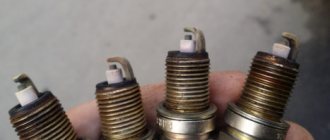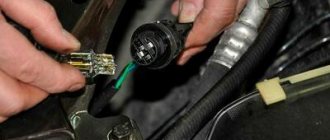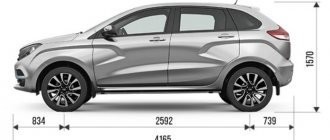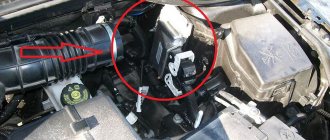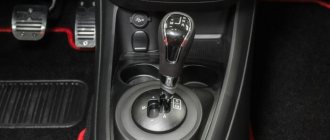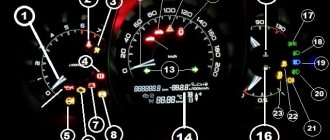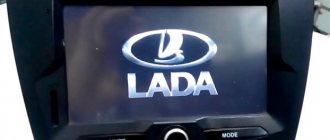Just a few years ago it was impossible to imagine the presence of a non-manual gearbox on Lada cars. Now a four-speed automatic transmission, a CVT and an AMT robot are being installed, which will be discussed further.
Menu
- Device
- Principle of operation
- Advantages
- Flaws
- Application
- Results
The AMT robot appeared in 2014. This version is called AMT-1 or VAZ-21826. In 2022, the firmware was rewritten and the name AMT-2 or VAZ-21827 was changed.
Which models are equipped with an AMT gearbox?
This robot is installed on Lada cars only with 16-valve power units:
Lada
| Vesta sedan 2180 | 2015 - present |
| Vesta SV 2181 | 2017 - present |
| Vesta Cross 2180 | 2018 - present |
| Vesta SV Cross 2181 | 2017 - present |
| Granta sedan 2190 | 2015 - present |
| Granta hatchback 2192 | 2018 - present |
| Granta liftback 2191 | 2018 - present |
| Grant station wagon 2194 | 2018 - present |
| Granta Cross 2194 | 2019 - present |
| X-ray hatchback | 2016 - present |
| Priora sedan 2170 | 2014 — 2015 |
| Priora hatchback 2172 | 2014 — 2015 |
| Priora station wagon 2171 | 2014 — 2015 |
| Kalina 2 hatchback 2192 | 2015 — 2018 |
| Kalina 2 station wagon 2194 | 2015 — 2018 |
| Kalina 2 Cross 2194 | 2015 — 2018 |
Review of VAZ Granta 1.6 (year)
July 23 mileage: 2000 km.
Review: Granta 1.6 16v AMT (robot)
I wish you all good health! Reading reviews is of course pleasant and useful, now you also need to make your contribution, so don’t judge harshly, especially for mistakes (I was in a hurry, and I want to write more + no, the beech is stiff and the buttons are small).
Lada Granta (luxury equipment)
ICE: 1.6 16 cl. 106 l/s, gearbox: 5st. robotic.
Equipment: ABS 2PB 4ESP Climate Heated front seats Rain sensor Two rear parking sensors Fogs Wheels R15 Radio with touch control Standard alarm.
Over the 11 years of driving experience, I personally owned: the first was my grandfather’s Moskvich 412 (whatever this car couldn’t stand from me), then the VAZ 2105 1.3 1985. on gas (after Moskvich, a comfortable and stable car), VAZ 2106 2006. (drove for about 2 years), then an almost new 2105 (injection 5-speed, also drove for about 2 years), Toyota Platz 2001. (I got the car in excellent condition, drove it for 3 years, didn’t know any problems, but I wanted more and lost it), Nissan Cefiro 1998. 2.5 210 hp Neo-Di engine which does not run on gasoline below 95, the car is cool but already old and it eats gasoline normally + expensive insurance, taxes (drove for 2 months and sold it), Honda Civic 2000. 1.5 (8 valve automatic - I was shocked myself) right-handed sedan made for the Emirates, no ABS, no airbags, terrible heater. but there is a leather interior and climate control (the car was received in poor technical condition. I thought I’d do it little by little, but it didn’t work out due to financial difficulties, I thought it was about to break down BUT! the car was almost unchanged in technical parts, traveled 3 -and years... low bow to her, the car is really very reliable and durable, although it is designed for good roads and active driving, so the chassis is quite harsh). All cars are worthy of special attention, but we are not talking about them now. And now. TA-DAM! New Lada Granta))
Design of a robotic gearbox AMT or VAZ 2182
The idea of creating their own automatic machine was nurtured by AvtoVAZ designers for many years, but they lacked the qualifications. Therefore, we decided to turn to foreign specialists again.
At first, negotiations took quite a long time with the famous Italian company Magneti Marelli, but the offer received later from the German concern ZF turned out to be much more profitable. As a result, AvtoVAZ management decided to equip the currently most modern domestic mechanics, the VAZ 2180, with electromechanical actuators from a German company.
A
— clutch actuator;
B
— gear shift actuator;
B
— clutch fork;
G
— speed sensor on the input shaft;
D
— control knob in the cabin.
1
— gear selector rod;
2
— gear shift drive;
3
— gear selection drive;
4
- electric motors.
1
— drive gear;
2
— clutch fork rod;
3
— wear compensator;
4
- compensation spring;
5
- electric motors.
The result was a typical robot with an electric drive of a single clutch disc. Such models were popular among European or Japanese manufacturers ten years ago. At the moment, almost all the leading automobile concerns in the world have long abandoned them in favor of an even more modern transmission: preselective robots with two clutches.
This issue of Good Mechanics is entirely dedicated to the very first domestic manual transmission.
Similar transmissions from other manufacturers:
General information about the AMT robot
- The mechanical part is based on a five-speed modification of the VAZ model 2180 gearbox. Moreover, this gearbox is equipped with gear pairs with different output ratios for different Lada models. For example, the Vesta box has this output indicator of 3.9, when, as on Grants and Kalinas, it is 3.7.
- You cannot take an actuator (clutch pressing mechanism) and robot electronics and put it on a regular box of the same VAZ 2180 model so that the result is a robot. Although the reverse procedure of replacing a robot with a mechanical one can be carried out with overcoming some obstacles.
- It is believed that the actuator cannot be repaired or maintained, but this is not for our craftsmen. Cases of its failure, judging by the reviews, are very rare. Usually, they happened at the beginning of operation, while still under warranty. There were no cases of refusal to replace.
- The recommendation to change the oil in the AMT at a mileage of 120 thousand does not stand up to the criticism of mechanics; they recommend doing this at 75 thousand mileage.
- The adaptability or adaptability of the transmission to changing operating conditions of the engine and its load, the position of the gearbox engaged mode sensors (ECP), as well as the gas and brake pedals is ensured by reading the sensor information and analyzing this information. And based on the algorithms embedded in the robot’s program, a certain order of its actions is formed. In this case, the driver’s actions in various situations are taken into account, which are stored in the robot’s long-term memory. If we say all this in a simple and understandable language for everyone, then the AMT transmission adapts to the characteristics of the driving style of a particular driver and road conditions. Moreover, for this she usually needs a couple of tens of kilometers of driving in the city.
- The AMT robot is sensitive to engine load and quickly responds to the activation of maximum torque. At the same time, each subsequent gear can be engaged only when the engine speed drops below 2.5 thousand, and each subsequent one when the range from 4 to 4.5 thousand revolutions is reached. In addition, the degree of load perceived by the engine is taken into account. For example, on a slope, the AMT robot will switch to a lower gear if the load on the engine decreases, but will leave it in the most economical operating mode.
- AMT has its own peculiarities of operation in accordance with the established transmission modes. For example, in “M” mode, the gearbox switches faster compared to “A” mode.
What operating features does the AMT robot have?
The robot has 4 operating modes, each of them has its own letter designation:
- neutral;
- reverse gear;
- automatic mode;
- manual mode.
In manual mode, the driver himself changes gears by swinging the control lever back and forth, while the automatic takes care of only pressing the clutch. But when the revs reach too high, the transmission will change gears on its own to save itself from damage.
Algorithm of operation of the AMT box
The AMT gearbox operates in the following order:
- Start the engine.
- Clutch rupture of power waves.
- Determining the desired gear.
- Clutch activation.
- Accumulation of revolutions during accelerator operation.
- Start of vehicle movement.
Gear selection occurs automatically. The information coming from the indicators helps the electronic control center determine the desired driving option. However, the driver, if necessary, has the ability to independently control when switching to semi-automatic mode.
Watch the video What is a robotic gearbox - 8:00 minutes.
Disadvantages, breakdowns and problems of AMT
The robot inherited from the mechanics of the 2180 regular oil leaks from the seals. There is nothing much you can do; carefully monitor the lubricant level.
Sometimes the robotic box goes into a stupor and stops responding to commands. In this case, only flashing the control unit will help you.
Sometimes vibrations bother you when the clutch disc wears out at low mileage. Only replacement helps. In 2016, AvtoVAZ changed its supplier and the problem went away.
The following video will tell you in detail about the symptoms of sudden transmission overheating.
5 AMT transmission service
According to the manufacturer, the 5 AMT transmission does not require maintenance, its elements are protected from dust and moisture, which in turn has secured the transmission’s reputation as a simple, reliable, trouble-free mechanism.
However, it is recommended to adhere to the following rules:
- Monitor the oil level; mechanical damage to the box may cause it to leak;
- Adapt the robotic gearbox clutch in a timely manner.
The box is a set of gears controlled by a ZF actuator. The clutch of the box wears out over time and needs to be adjusted to the actuator, this process is called adaptation, it is designed to eliminate jerks and shocks when moving.
Adaptation is carried out:
- Every 15,000 km of vehicle mileage;
- In case of clutch replacement;
- When updating the on-board computer settings.
The process is simple and takes a few minutes: the car is connected to the AvtoVAZ computer through a special diagnostic connector, the electrician turns on the program and directly communicates with the manufacturer’s server. The data is downloaded to the server, after which the engine starts and adaptation occurs within a few seconds.
It is advisable to have the box diagnosed by an official representative, since the work will require special equipment and trained personnel.
Lada cars with AMT reviews from owners
Most often, owners of cars with such a manual transmission complain about delays or jerks when switching. They are especially noticeable when driving in city traffic or when starting up a hill. Sometimes this robot generally behaves inappropriately, sometimes it will drop several gears for no reason, sometimes, on the contrary, it drives for a long time and strainedly at high engine speeds, without even intending to shift.
The second inconvenience is the lack of a rolling mode, as on a hydromechanical automatic transmission, which is so convenient in traffic jams. When a car slowly crawls in automatic mode, after releasing the brake pedal, everyone expects that they will move on, because the gearbox is in gear. But no, you need to press the accelerator. Update: version 21827 received a rolling mode.
Advantages
- Cheapness. AMT is more profitable to produce than an automatic or CVT, so the end buyer gets cars with a robot at a lower markup.
- Efficiency The efficiency of the AMT robot is comparable to that of a manual transmission. The power loss from gear operation is about 2%.
- Unlike the driver, the robot's actuators try to extend the life of the box, and changes gears more slowly and smoothly than a human could. Therefore, switching to higher gear occurs with some delay, which increases fuel consumption.
- There is an imitation of a creeping mode, like on an automatic transmission (VAZ-21827).
Price of VAZ AMT robotic gearbox
It is very difficult to buy a new or at least used manual transmission 2182 at this point in time, just as there are practically nowhere qualified specialists for repairing such transmissions. Therefore, owners of out-of-warranty cars with a robot are left with a large-unit replacement.
The cost of spare parts for restoring the VAZ 2182 or AMT robotic transmission:
| Box VAZ 2180 | RUB 38,450 |
| ZF gear shift actuator | RUR 56,643 |
| ZF Clutch Actuator | RUB 35,756 |
| Large-unit replacement work (on average) | RUB 9,350 |
The price of parts for just such a box is briefly discussed in this review.
You can contact the site administrator by email: [email protected]
All texts were written by me, are authored by Google, included in the original Yandex texts and notarized. For any borrowing, we immediately write an official letter on company letterhead in support of search networks, your hosting and domain registrar.
Next we go to court. Don’t try your luck, we have more than thirty successful Internet projects and have already won a dozen lawsuits.
Tips for optimal driving with an AMT gearbox
Not every driver can quickly adapt to driving a robotic gearbox, especially if his vehicle previously had a different type of transmission. There are small tricks that are recommended by experts who have dealt with the robot box.
- Overheating of the clutch may occur in the AMT box. The AMT gearbox is especially susceptible to such overheating during forced stops in traffic jams. Therefore, when stopping for more than 10 seconds, it is advisable to set the mode to neutral, and on steep climbs to artificially reduce the gear.
Otherwise, when the box overheats, the overheat indicator on the panel lights up, after which it takes time to turn off the engine and give the engine time to cool down. The clutch basket, release bearing and driven disc will also wear out.
- Jerky movements of the car while accelerating are a distinctive feature of a robotic gearbox. To avoid such jerks, the gas accelerator is pressed and then released when it feels that a gear change is about to occur. It is advisable to increase the speed after switching. Experts also advise taking the robot slowly when accelerating – you need to drive using “half the travel” of the right pedal.
- The robotic box must be calibrated during the annual technical inspection. This way you will significantly increase the period of its operation.
- Before turning off the engine and driving the car to the parking lot, it is better to leave the gear engaged. For added safety, always use the parking handbrake. A working handbrake is an important condition for the safe use of a car with a robotic gearbox.
By following these simple recommendations, you can significantly improve the efficiency and comfort of your trips. Practice shows that both a novice and an experienced driver can easily learn how to handle a robot correctly.
Test drive Lada Granta liftback with AMT robot
The other day we took a test drive in a Lada Granta liftback equipped with an AMT robot. Feedback and impressions are in today’s material.
Granta in the liftback body immediately after its appearance caused mixed opinions. Some people didn't like its design, others didn't like it. Indeed, the rear of the car has changed significantly. Compared to the Grant sedan, the liftback looks a little more modern and fresh. In addition, in this body the car does not look as bulky as a sedan.
To be honest, in the modern AVTOVAZ line, this liftback looks very good. Unlike the sedan, many minor “sores” and childhood illnesses were improved on the liftback. For example, doors open and close with much less effort and noise, thanks to new closers. Hooks for attaching bags appeared in the trunk, plastic cables for securing the rear parcel shelf were replaced by elastic laces that do not burst in the cold, etc. The combination of these changes creates a more pleasant perception of the car.
The trunk volume of the Lada Granta liftback is a good 440 liters, and with the rear seats folded it reaches 760 liters. This is where the main advantage of the liftback body manifests itself - the large tailgate opens completely and makes loading and unloading easy.
The interior design is exactly the same as on a sedan - everything is simple and without frills, the usual interior of a budget car. Naturally, the interior also depends on the configuration - the base will not have a large LCD monitor and other goodies.
Under the hood of the test car there is a 106-horsepower 16-valve engine paired with an AMT robot. Behind this abbreviation lies an ordinary robotic gearbox, which is successfully used by many manufacturers. This is a simple and cheap solution, popular in the budget segment. “Robots” with one clutch were installed on some models of Peugeot, Renault, Toyota, etc.
In the cabin, instead of a gearshift lever, an AMT selector is installed, and there is also no clutch pedal. The selector has a neutral, forward, reverse, and manual mode. Unlike a traditional automatic, the AMT does not have a “Parking” mode; the car must be left in neutral when parked or turned off while the gear is engaged. This is one of the disadvantages of the Lada Granta with AMT - in winter, after washing the car, in order to avoid freezing of the pads, you will have to leave it with the gear engaged and without a handbrake, which will not allow you to use the automatic engine start.
Another disadvantage of AMT on the Lada Granta is maneuvering in a parking lot. The fact is that when the brake is released, the car does not start moving, like a classic automatic. In order for the car to move, you need to increase the speed of the gas pedal. Sometimes this causes shocks when maneuvering forward and backward in a parking lot - you need to get used to it.
Oh yes, the robot won’t go without warming up either - when you try to start in winter, immediately after starting the engine, the car does not react in any way to turning on the driving mode and pressing the gas. But a couple of minutes after launch - already please.
On the move, the Lada Granta behaves like a typical car with a robot. Here you won’t be able to just drive and not think about anything, like in a car with a conventional automatic transmission. You need to understand that a robot is the same mechanics that is simply switched not by a person, but by electronics. Therefore, between switching there is a noticeable pause, and sometimes even a noticeable “peck”. However, there is a trick here too. After a while you begin to intuitively feel the moment of gear shifting. If you slightly release the gas pedal before doing this, the switching occurs very smoothly and quickly. Much better than many manual drivers switch.
Another nice feature is that if you press the gas to the floor, the robot in each gear allows the engine to spin up almost to the red zone of the tachometer, and then quickly switches to the next speed. There is also a manual shift mode: if you need to accelerate sharply, you can downshift manually. This is useful, for example, when overtaking on the highway.
In general, Granta and the robot have both disadvantages and advantages. But in terms of price, the robot will cost the buyer significantly less than a classic machine. In principle, it’s a pretty good alternative for those who are tired of working with the clutch and gearshift lever, but don’t want to overpay for an automatic.
Popular rumor is a scary thing. Take robotic gearboxes, for example. The amount of knowledge about them among the population is approximately the same as that of teenagers about intercourse: someone has heard something, someone knows something about how, where, and most importantly - why, but few have seen and understand what it is. actually.
Judging by forum remarks from buyers and even reviews from less experienced colleagues, few people like the VAZ AMT the first time: it doesn’t know how to do it, it doesn’t do that, it’s unlucky... How could it be otherwise if you don’t know what to eat it with?
The “robot” cannot be approached as a classic AT. It's not AT because. In essence, this is the same mechanics, only the closing and opening of the clutch discs is controlled by automation. In classic ATs, instead of a clutch, torque goes to the drive axle through a torque converter. That’s why the operation is a little smoother than that of the RT, but a considerable part of the power is lost in the torque converter fluid. This is especially true for cheap boxes of this type.
Automatic transmission from Renault: torque converter, a bunch of gears, extra weight...
A robot is an intermediate thing. When you want two pedals, but also save money. And not only for the buyer, but also for the manufacturer. And so it happened: the AMT box was made on the basis of the old VAZ mechanics: specialists from the German ZF attached actuators to it (the same ones that control the clutch engagement). Therefore, the work was done very quickly.
In fact about the robot: Is it worth buying a car with a Robot?
If you are interested in the question of whether it is worth buying a robot, we will tell you: sign up for a TEST DRIVE, because it is free. Only by experiencing the robot’s operation yourself will you be able to understand whether it is suitable for you or not. If it doesn’t fit, then a manual transmission package is waiting for you.
AvtoVAZ says that the gearbox is suitable for everyone; AMT has 20 different switching algorithms. But this is not entirely true.
A little from myself: If you have a harsh character and you need appropriate behavior from a car, a robot is not for you. The robot is designed for calm, leisurely driving at medium speeds with smooth shifts and saving fuel and the clutch disc. And the question immediately arises of how this transmission will perform on Vesta Sport: how much the settings will be changed, whether sportiness will appear, etc.
Lada Granta AMT: conclusions and performance characteristics
| We like | widespread work on bugs; new rear view mirrors; a domestic robot that is better than Opel’s and Toyota’s. True, mid-2000s. |
| We do not like | nostalgic communal crampedness |
| Data is given for Lada Granta AMTc with 1.6 engine and MT | |
| Engine | petrol |
| Number and arrangement of cylinders | 4 in a row |
| Working volume, cm³ | 1 596 |
| Max. power, hp | 102/5800 |
| Max. torque, Nm | 148/4000 |
| Drive unit | Front |
| Transmission | robotic, 5-speed |
| Front suspension | independent, with McPherson struts and anti-roll bar |
| Rear suspension | semi-independent, lever, spring |
| Front brakes | d claims |
| Rear brakes | drums |
| Maximum speed, km/h | 180 |
| Acceleration time sec. | 12,3 |
| Dimensions, mm | |
| length | 4 260 |
| width | 1 700 |
| height | 1 500 |
| wheelbase | 2 476 |
| ground clearance | 160 |
| Curb weight, kg | 1 075 |
| Tires | 175/65 R14 |
| Trunk volume, l | 520 |
| Fuel consumption, l/100 km | |
| urban cycle | 9 |
| suburban cycle | 5,2 |
| mixed cycle | 6,6 |
| Fuel tank volume, l | 50 |
We thank AMK-Ekaterinburg for the test car. Text: Kirill Zaitsev Photographer: Nikolay Kovalevsky Illustrations, graphics: Jatco, Renault, Lada, archive 66.RU
Roskomnadzor killed the Telegram bot 66.RU. Subscribe to the backup channel.
Features of the “behavior” of the robot after running in
As a rule, after running-in, the robot and the driver adapt to each other. The driver already automatically starts the engine from the neutral position of the lever and simultaneously presses the brakes. Gear changes have returned to normal and become shifts without interruption in the power flow or without "jerking".
Some reviews regarding the “behavior” of the robot after running-in recommend not to “fall” on the gas pedal when starting to move, trying to quickly gain speed to switch from the initial speed to the next one. This manipulation does not give the desired effect, however, the transition from second gear to third and subsequent transitions will be carried out much faster, unless, of course, you reduce engine speed by releasing the gas pedal.
Reliability, weaknesses, maintainability
Reliability
Due to the short service life, there is no specific data on engine reliability yet. But according to the manufacturer’s forecasts, the VAZ-11182 is considered the most successful option among all VAZ 8-valve engines. Accordingly, the new motor is positioned as quite reliable.
The development of new, “stickless” pistons has significantly raised the spirits of car owners of this internal combustion engine. Gone are the nightmares about the possible consequences of a broken timing belt - bending of valves, destruction of the piston and expensive repairs.
The bearings and connecting rods are copied from the VAZ-21179 engine. The crankshaft is updated, but the connecting rod journal is identical to the crankshaft journal of the same 1.8-liter VAZ-21179. Here the priority was to reduce mechanical friction losses and increase reliability.
It is clear that the maximum loads of the 122-horsepower and 90-horsepower engines differ significantly from each other. Thus, the VAZ-11182 crankshaft contains an additional safety margin, which increases its reliability.
It is appropriate to note that more than 20 items of parts and components have been replaced on the engine. It is characteristic of the VAZ-11182 that all new changes in the mechanical part were made not by designed parts, but by previously used parts and assembly units that had already proven themselves in practice.
For example, valve stem seals are taken from the H4M engine (developed by Nissan, produced by AvtoVAZ). From the same engine, valve tappets and crackers are used.
The first reviews, or rather, discussions about the engine, appeared on the forums. So, StAndr writes: “... the pistons have become heavy with a good compression distance, the connecting rods are now centered on the crankshaft cheeks, and not on the piston bosses. The block is cast iron, not aluminum, like on foreign cars - it holds the geometry well. There are oil nozzles. The torque is not bad - 143 Nm, and from 1000 rpm 80% of the torque is available, i.e. 114 -115 Nm."
The changes made to the internal combustion engine of the VAZ-11182 allow us to hope that the engine will be highly reliable.
Weak spots
The engine has not yet had time to prove itself in operation, so there is no information about its weak points. But on the forums you can find scant data on this issue.
For example, one of the owners of the VAZ-11182, in all likelihood, had to deal with disassembling the engine. In his review, he noted that there was rough surface milling on the plane of the cylinder block. As a result, problems arose with oil and coolant leaking through the head gasket.
But such reports are rare, and it is too early to judge whether the error in block processing is a weak point.
Sometimes the engine shakes at idle speed. Replacing the spark plugs and adjusting the ignition mechanism eliminates this problem.
Some engines have increased oil consumption. Usually this problem occurs around 80-100 thousand kilometers. Oil intake can be about 900 grams. per 1000 km. The true reason for this phenomenon has not been clarified, but it is believed that the design feature of the CPG is to blame.
Maintainability
The maintainability of the unit is good. But it should be noted that the repair process itself is complex. You can't do this without experience and special tools. Forum member 46B writes: “...now you can’t adjust the valves in the garage, you have to disassemble half the engine, and the price of pushers is from 1,500 rubles. for 1 piece."
In general, there are no problems with finding spare parts. The only trouble is that you can run into a fake. The Chinese manufacturer is especially famous for counterfeit products.
Therefore, when restoring an engine, it is recommended to use only original components and parts.
The modern VAZ-11182 engine is a completely reliable and economical engine, but only if it is handled accordingly.


